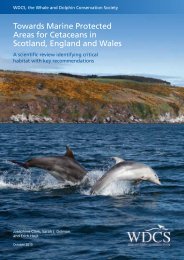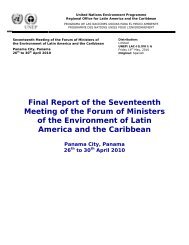Sea Turtle Recovery Action Plan for Barbados - WIDECAST
Sea Turtle Recovery Action Plan for Barbados - WIDECAST
Sea Turtle Recovery Action Plan for Barbados - WIDECAST
Create successful ePaper yourself
Turn your PDF publications into a flip-book with our unique Google optimized e-Paper software.
<strong>Barbados</strong> <strong>Sea</strong> <strong>Turtle</strong>s …<br />
geable residents report that sea grass beds have diminished in size over the past two decades.<br />
Increased inputs of sediment, resulting in clouding of the water and a reduction in rates of<br />
photosynthesis, and increased inputs of herbicides and pesticides via land runoff are implicated<br />
in sea grass decline. <strong>Sea</strong> grass beds and coral reefs are both important to green turtles, <strong>for</strong> whom<br />
they provide food and shelter, respectively. The relative scarcity of green turtles as compared to<br />
hawksbills may perhaps be explained by the lack of sea grass around <strong>Barbados</strong>.<br />
<strong>Barbados</strong> is a coral island dotted by fringing reefs and a more or less continuous bank<br />
reef approximately 1 km offshore along the western and southern coasts (Map 2). A principal<br />
component of the diet of hawksbill turtles is reef-encrusting sponge; thus, <strong>for</strong> hawksbills, reefs<br />
are used not only <strong>for</strong> shelter but also <strong>for</strong> food. Over the past twenty years the health of fringing<br />
reefs has declined, due primarily to poor nearshore water quality (see also sections 4.143, 4.146,<br />
4.147). Bellairs Research Institute, under contract from the Coastal Conservation Project Unit of<br />
the Ministry of Labour, Consumer Affairs and the Environment, conducted the first quantitative<br />
benthic survey of the fringing and bank reefs on the south and west coasts of the island<br />
(Oxen<strong>for</strong>d et al., 1989). The survey provided baseline data on the present state of the reefs and<br />
will allow any future changes in reef health to be quantitatively assessed. The survey also<br />
quantified fish abundance and diversity, and coverage of hard coral, soft coral and algae.<br />
Preliminary nearshore surveys (line transects) at water depths of 3-15 m along a northern<br />
section of the west coast of <strong>Barbados</strong> were conducted by Bellairs Research Institute in<br />
July-August 1991 as part of their sea turtle conservation activities. Juvenile turtles (greens and<br />
hawksbills combined) were encountered at a rate of about 0.4 per km. No adults were observed.<br />
The only in<strong>for</strong>mation available to date on <strong>for</strong>aging habitat used by sea turtles is qualitative,<br />
consisting of occasional sightings from the cliffs along the northeast coast and reports from<br />
SCUBA dive operators visiting the same areas repeatedly. A comprehensive long-term survey is<br />
needed in which dive operators, marine research scientists, and fishermen should all be<br />
encouraged to participate. The dive operators have already expressed a willingness to take part<br />
in small-scale surveying of nearshore <strong>for</strong>aging habitats. This cooperation will be very useful in<br />
assessing the relative importance of various coastal habitats.<br />
4.112 Survey nesting habitat<br />
The Coastal Conservation Project Unit (CCPU) is an agency within the Ministry of<br />
Labour, Consumer Affairs and the Environment. It was established in 1983 to advise on coastal<br />
erosion matters. Its routine activities include monitoring of beaches around the island and the<br />
review of applications made to the Town <strong>Plan</strong>ning Department (Ministry of Housing and Lands)<br />
<strong>for</strong> any proposed coastal development. The CCPU surveys 38 beaches at 3-month intervals, 20<br />
at 2-week intervals, and 17 annually. The resulting profiles allow changes that have taken place<br />
over the past five years to be quantified, and strategies <strong>for</strong> subsequent beach stabilization<br />
measures to be developed. These data are also very useful <strong>for</strong> the long-term monitoring of sea<br />
turtle nesting habitat.<br />
The first comprehensive attempt to survey beaches <strong>for</strong> sea turtle nesting activity was<br />
made in 1987 in preparation <strong>for</strong> WATS II, the Second Western Atlantic <strong>Turtle</strong> Symposium<br />
(Horrocks and Willoughby, 1987). It was estimated that from June to August (peak nesting<br />
period) there were about 44 km of suitable nesting beaches around <strong>Barbados</strong>; where a suitable<br />
Page 11

















